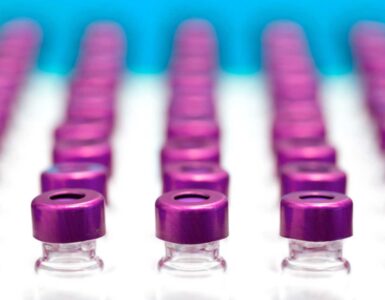As CEO of closely-held AuraSense Therapeutics, Dr. David Giljohann is one of the original inventors of the company’s technology for first-in-class therapies based on its proprietary spherical nucleic acid (SNA) platform. In fact, the technology is based on his graduate work at Northwestern University with advisor Chad Mirkin, one of the founders of AuraSense and current chairman. Dr. Giljohann was the first employee of AuraSense LLC, the parent company of AuraSense Therapeutics. He has a proven track-record of product development and commercialization and was responsible for spearheading the commercialization of the SmartFlare technology for research use, which was licensed to EMD Millipore 18 months ago. EMD Millipore currently sells SmartFlare to researchers in over 20 countries. Dr. Giljohann is a co-author of over 25 manuscripts, and a co-inventor on over 100 patents and patent applications. In this interview with BioTuesdays.com, Dr. Giljohann discusses how the SNA technology could revolutionize personalized medicine and gene regulation.
Let’s begin with a brief history of the company.
AuraSense is developing gene-regulation therapies for hard-to-treat diseases, including bacterial infections, skin disease and cancer. We were spun out of Northwestern University in 2009 as AuraSense and in 2011 we created AuraSense Therapeutics. AuraSense holds all the research rights to the technology and AuraSense Therapeutics holds all the therapeutic rights to the SNA technology. From 2011-2015, we have raised a total of $27-million for the therapeutics business through a combination of angel investors and federal grants.
Can you give us a brief overview of the technology?
We have discovered that when we arrange linear nucleic acids in a 3D format to create SNA structures, we can effectively deliver these nuclear acids into cells. The rest of the industry has been looking at nucleic acids in a linear format for delivery into the liver. But our premise is that 3-dimensional architecture matters, and is enabling for gene regulation beyond the liver. We are the only company that can make, modify and use SNAs for therapeutic applications and our IP portfolio exceeds 130 total filings, with 25 issued or allowed patents.
What are oligonucleotides and SNA?
Oligonucleotides are pieces of nucleic acid, essentially the primary nucleobases of cytosine, guanine, adenine and thymine that comprise your DNA. These can be chemically combined in the laboratory to make oligonucleotides. Oligonucleotides are designed to target a particular diseased gene of interest inside the cell. SNAs thus enable both the delivery into the cell and the attachment of the therapeutic to the diseased gene of interest.
Oligonucleotides are a new wave of personalized medicine and gene regulation to interfere with production of diseased genes. The challenge in the field is that linear nucleic acids historically have only been delivered to the liver. We have created a spherical presentation of nucleic acids, or SNA, that enables delivery outside of the liver and delivers an effective concentration of oligonucleotides to get into cells to inhibit production of diseased proteins. This concept was so counterintuitive at the time that it was published in Science in 2006.
What’s the therapeutic advantage of SNA?
Firstly, SNA constructs effectively enter cells without being encapsulated in a lipid or polymer. The arrangement of oligonucleotides within an SNA gives rise to dramatically enhanced cellular uptake, compared with the same nucleic acids not organized in an SNA format. This is a big deal because nobody has been able to show this before.
Secondly, we have shown that SNA constructs penetrate into the epidermis after being applied to the surface of human skin. We believe that this important property enables gene regulation in the skin, which in turn confers the SNA a substantial competitive advantage for the treatment of skin disorders with well-defined etiology. Psoriasis is one such skin disorder.
Thirdly, SNA constructs composed of immuno-stimulatory oligonucleotides are capable of producing a stronger innate immune response than the constituent nucleic acids. The SNA constructs drive the activation of innate immune cells, leading to enhanced function and secretion of cytokines in a greater magnitude and for a longer period, compared with conventional immuno-stimulatory oligonucleotides, and we believe that this enhanced response will result in increased therapeutic efficacy.
And finally, SNA constructs can act as scaffolds that present both immuno-stimulatory oligonucleotides and antigens on their external surface, which we believe increases their efficacy when compared with systems that encapsulate or otherwise shield the immunological payload from the cellular receptors that initiate immune responses.
Can you describe the lead product in your pipeline?
We have created a cream version of our SNA that penetrates skin and regulates a gene that causes psoriasis. In our case, we are targeting the gene, TNF-alpha, which is the same gene that Humira targets, but of course, Humira is a systemically delivered antibody. Using pieces of human psoriatic skin, we have shown that we can hit the same target with a cream. This is a very strong pre-clinical package, as we have both confirmed penetration in diseased skin as well as knockdown of our target gene. We plan a regulatory filing in 2015 for approval to go into the clinic in early 2016.
We have also announced that our AST-008 immuno-oncology product will target bladder cancer. When we delivered AST-008 directly into the bladder, we have increased the median survival of mice with very aggressive human bladder cancers by 63% and saw tumors shrink by 50%. Our results were comparable to commercially used mitomycin C, but without the side effects. We are hoping to file an IND for bladder cancer in 2016.
Do you have any plans to go public?
The market has been very favorable to companies such as ours over the past year or so and going public is on our radar. If the timing is right, it’s something that could happen sometime in 2015.







